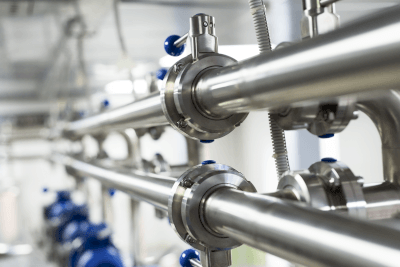What Is Sanitary Piping?

Sanitary piping, primarily used in the food industry and pharmaceutical plants, is designed for environments where cleanliness and hygiene are paramount.
All sanitary piping is constructed from stainless steel, specifically grades such as SUS304 or SUS316. The key distinction between sanitary and ordinary piping lies in the surface treatment. Sanitary pipes typically have a buffed outer surface and at least a bright annealed (BA) inner surface, while higher-grade options feature an electropolished (EP) inner surface to minimize liquid accumulation.
Uses of Sanitary Piping
In the food and pharmaceutical industries, where contamination from foreign matter or bacteria is unacceptable, sanitary piping is essential. Even minor liquid buildup in the food industry can lead to bacterial growth, potentially impacting the product and, in severe cases, causing significant public health concerns.
Similarly, in pharmaceutical manufacturing, any contamination by foreign substances or bacteria can have serious implications, given that these products are often used directly in the body.
Principles of Sanitary Piping
Most sanitary piping is made from either SUS304 or SUS316 stainless steel. This material choice ensures rust resistance and chemical resistance to agents like hot water and caustic soda used in Clean-in-Place (CIP) processes. The BA and EP finishes on these pipes prevent tiny fluid accumulations, a common source of bacterial growth, thereby significantly enhancing product safety.
Unlike sanitary piping, ordinary SUS piping often retains fine scratches and is not suitable for use in the food or pharmaceutical industries. While high-quality sanitary piping would be ideal for all applications, it is considerably more expensive than ordinary piping. Additionally, its effectiveness is fully realized only when used with dedicated joints, necessitating specialized knowledge in design and installation.
Sanitary Piping Standards
Sanitary piping, referred to as TBS, is specified in JIS G 3447. Nominal diameters are expressed in inches, ranging from 1S (O.D.=25.4 mm) to 6.5S (O.D.=165.2 mm), with a uniform wall thickness for each size (e.g., t=1.2 for 1S and 1.5S). Available in lengths of 4m or 6m, these pipes come with various surface finishes like pickling, internal buffing and polishing, with an option for electrolytic polishing on the inside.
Sanitary piping is made from austenitic stainless steel like SUS304, SUS304L, SUS316, or SUS316L, selected for its excellent corrosion resistance. This is particularly crucial in applications where chlorine ion concentration is high, as in certain food and pharmaceutical industries.
Sanitary Fittings
Sanitary fittings include “ISO Ferrule union fittings,” “ISO threaded union fittings,” and “flange fittings. Typical fittings are ISO Ferrule union fittings, which include elbows of various sizes (45°/90°/88.5° for flow gradient), cheese, crosses, reducers for connecting odd-shaped sizes, ferrule caps for closing ferrule ends, welding ferrules for pipes and tanks respectively, and clamps for joining two ferrules. There are a variety of joints, including two-piece, three-piece, hand-tightened, and bolted joints.
ISO threaded union fittings and flange union fittings are also available in almost similar types, allowing various piping systems to be assembled.
Gaskets for Sanitary Fittings
Gaskets for sanitary fittings include L-type gaskets for ISO threaded unions, Hercule gaskets for ISO Herule unions, and L-type gaskets for flange unions. Material choices include silicone, EPDM, FKM, Teflon, and Teflon-coated with EPDM core, selected based on the application. These gaskets are designed to not protrude inside the piping, ensuring unobstructed flow and no liquid pooling.